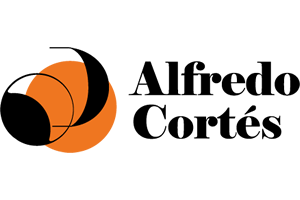Luis Royo’s work is marked by a fascination for the fantastic, apocalyptic and erotic universe that has conquered different international publishers with whom he has worked throughout his career. Rómulo Royo, on the other hand, is a painter specialized in large format works. On many occasions they have worked together, leaving egos aside, carrying out different projects from graphic novels to domes.
Workshop, studio… How do you conceive Laberinto gris?
Luis: I wouldn’t give it a title, it’s a work space. The work is done here on the upstairs floor, the downstairs area is there because the work has to be marketed because we have been called by publishers and galleries but at a given moment, in order for it to take shape and be fluid and let us work, it was better to separate the work area from the gallery area. There is also a web store and we sell work there and limited editions.
Romulo: The gallery part is separate from our work area. The gallery can even be used to expand projects. There is also work we do with other places (from heavy metal, which is an American house, to galleries). Apart from that there are other places with which we collaborate and move the work.
Luis: All people who do something creative also have to have time for the process from the moment you make the work until it reaches the public. The ideal dream would be to be only in the creative part. Dividing the part that commercializes, manipulates, organizes fairs in a different space goes very well so that when you are in the creative part you are very separate from that other part and you are focused.
In our work space we separate our zones. Because at the moment of working we can work together but sometimes in the creative moment it’s good to have moments alone, even if you then contrast it with the other. Even to make works alone, which we also do, which are independent. All that enriches.
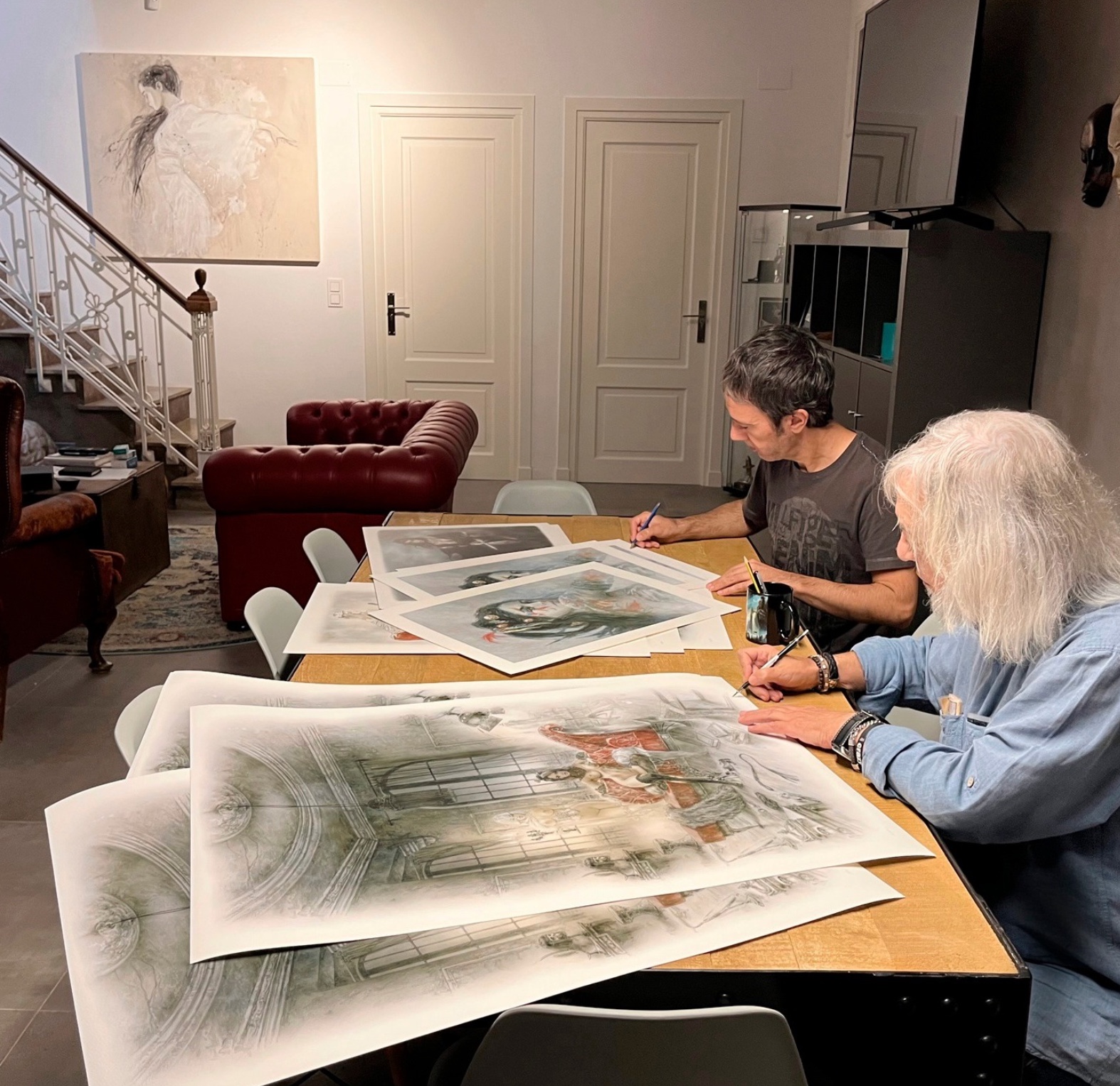
The opening of Laberinto gris coincided with the pandemic. How did this affect your plans?
Romulo: The pandemic was a break from doing things outside. Then we even had an exhibition at the Lucca Comics & Games fair, which is a pop fair, the most important in Europe and highly regarded worldwide, as well as the oldest.
There the exhibitions are prepared in very beautiful old palaces. The exhibitions are for chosen ones and we had an exhibition there and it was truncated by the pandemic. We were affected by the pandemic because we could not go to fairs but, nevertheless, as there are collectors who are faithful to the work, through Laberinto Gris, there were sales. Without being in a physical exhibition there are collectors in the world and there were sales. It affected us in terms of exhibitions, but in terms of operation it was not a total stoppage either.
Luis: The advantage is that we have never focused our work on a regional or Spanish public, always internationally, and that has its advantages. Not only in the pandemic, but also in rare moments when there has been a crisis because you don’t live in the same way since the crisis is appearing in the United States but here it has arrived later or things like that. So, you don’t feel that you are accompanying the events of the world at the right time, but that they arrive at different times.
Romulo: You think that the work has to be known worldwide, it’s like what you have in your head, but not because you think in a mercantile sense. Although it goes a little bit together.
IF YOU HAVE A NARROW VISION OF ONLY WHAT IS BEING DONE IN YOUR ENVIRONMENT, IT IS POSSIBLE THAT WHAT YOU ARE DOING WILL SOON BECOME A THING OF THE PAST.
Regarding what Luis mentioned about the crisis, for example, the publishing world has been hit hard by the crisis since 2008. Then, the books that are collector’s books were born and it has been increasing. As we are not focused on just one thing, maybe the crisis had a greater impact on mass publishing, but in other things it has been the other way around: the value of original illustrations and fantasy has increased. Figurative art has been established, which a few decades ago was relegated by critics, it was not considered modern art. For the last five years we are seeing that it is taking over. It is very beautiful and now the critics are beginning to value it. New critics are coming out who are very supportive of this new trend. If you have a reduced vision, of only what is being done in your environment, it is possible that what you do will soon become a thing of the past.
Luis: If you enter into so many fans of things, there may be a sector that is in crisis but another one is on the rise.
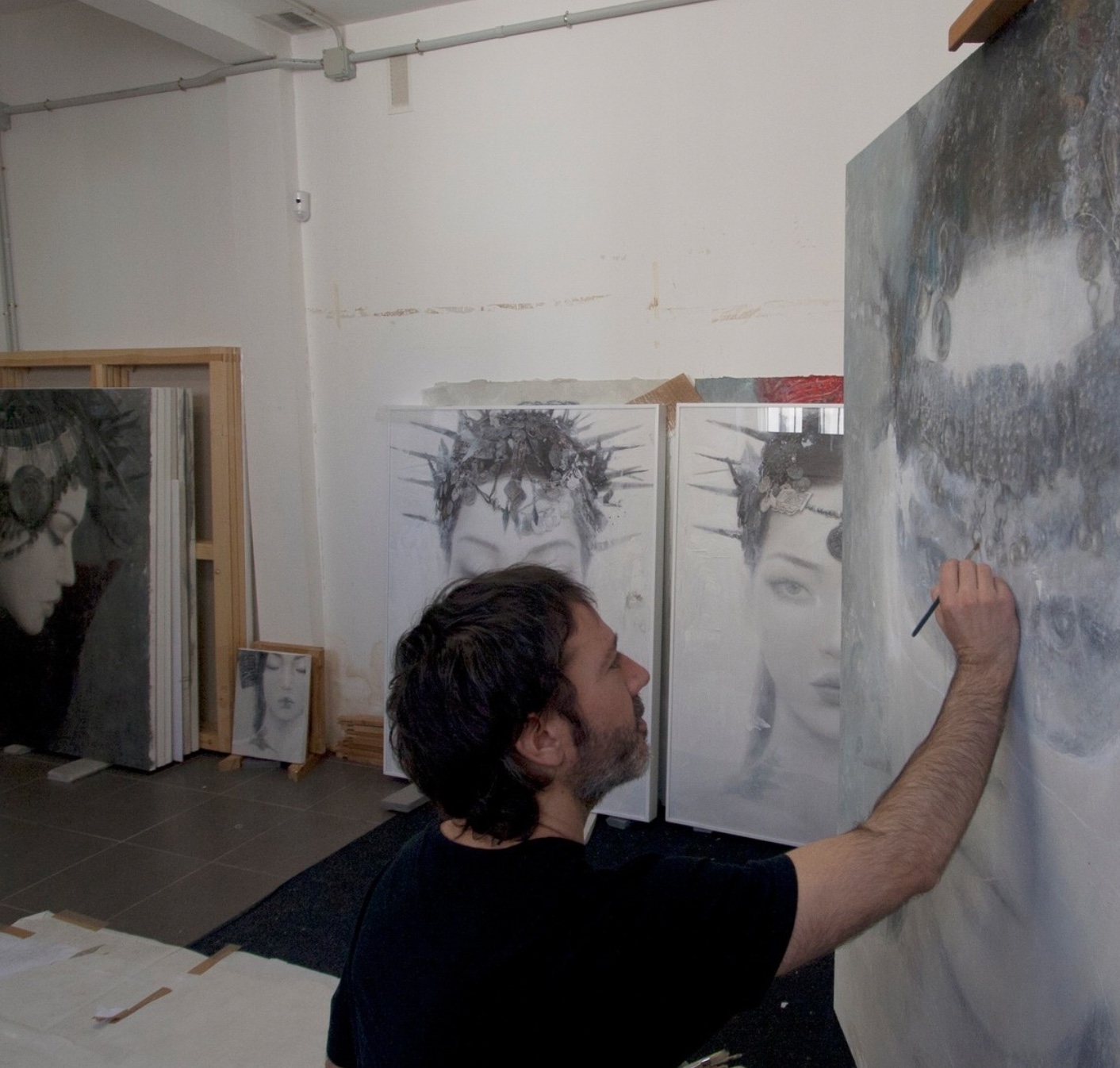
Has the acceptance of the fantasy genre been changing?
Luis: When I started in the eighties or nineties, adult comics were born, science fiction and fantasy literature boomed; the writers of this genre began to be in bookstores; stories that we feed on now, such as ‘Game of Thrones’ are literature of those years and we had to do many covers. In cinema we have a clear reference because those were the golden years of this because that’s when ‘Alien’, ‘Blade Runner’, ‘Star Wars’ came out… Video games also came out with all the aesthetics and authors that emerged. Drop by drop [fantasy] has been eating ground until today where spaces that were for a type of art that had to be very specific in very specific lines have begun to adapt.
Romulo has been halfway between painting and this type of illustration, I come more originally from the world of illustration. All this has been growing to the point that today you can sell these works in the gallery, you can see them at art auctions … They have been eating ground and have taken respect even from the elitist arts have had to respect. Even urban art is gaining ground.
Romulo: There are critics who support and value this art and say that it is valid because other currents are part of the past. For example, Donald Kuspit is a New York critic who is very supportive of this type of art or very important magazines like Juxtapoz or Beautiful Bizarre Magazine that are already in this movement.
When I was moving with the fairs, working with galleries but sometimes working alone, I was like going against the current because my style was not the usual. Suddenly, to put some fantasy being that the discourse of painting was another, it was true that I was alone. As time goes by it is also very gratifying because somehow this work is a lot of pulling you towards where you think it calls you or where you think you have to go, with doubts because there is nothing written.
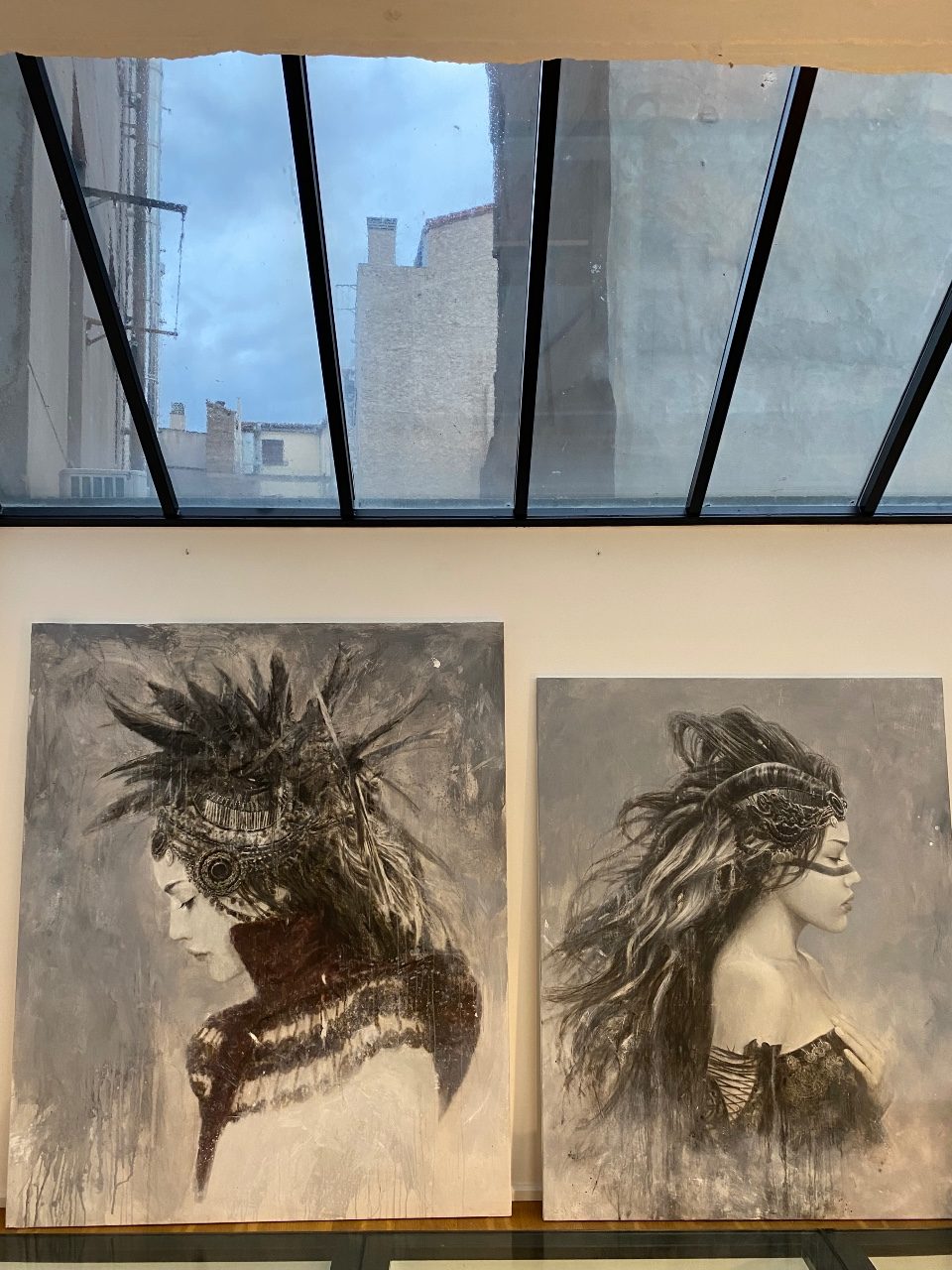
Genres have reached the mainstream that before were more reviled or seen as minor genres.
Luis: Little by little they have opened up to a wide audience and there is a large public and it feeds back. In the cinema itself they continue to feed off those first films and different versions have been made.
Romulo: There are already people with a cultural level, like Guillermo del Toro, who are collectors of fantasy art.
Luis: [Fantasy] has taken a hold that has grown to be massive. I remember ‘Game of Thrones’ being published in the eighties or nineties and it has become massive. It is a whole aesthetic taste that has been growing and has been assimilated by the public and also by the elitist part of the art critic who is very exquisite. For example, in Paris I remember that a gallery owner used to say that there were two galleries where this type of figurative paintings, close to illustration, could be seen. Five years later there were 14. The growth has been exponential.
IN ART IT IS NECESSARY TO TRANSMIT, BUT WITH THE PLASTIC ARTS
Does culture have to be transgressive?
Luis: Of course. It is noticeable in recent years: there is a kind of self-censorship in culture that has to be politically correct. Not only in Spain, but worldwide, and it is dangerous.
Romulo: A few years ago, in countries like Spain, in a way, people were painting for institutions, whatever they were going to award you. But it was a false market, you didn’t do it for your time but because it was of interest to a few or whatever. But that’s what art is: you have to be in your moment, to be transgressor…
Luis: At least ask yourself questions, question things. Art is vindicative if it tells me something that not all the media are telling me because otherwise it doesn’t vindicate anything. For example, the migrants who come in patera: we all know it, we have seen hundreds of very hard images. Don’t reflect, search, make us ask ourselves questions. Maybe [art] doesn’t have to be transgressive, but at least it should make you question things, ask yourself questions, never be in a comfortable point of view.
Romulo: And that the aesthetics reach you. Being transgressive doesn’t have to be something crude. For example, Joel-Peter Witkin is a photographer who works with dissections of the dead and creates still lifes that are aesthetically beautiful.
A few years ago there was only discourse in art and I don’t agree with that because art is not only discourse. In art you have to transmit but with the plastic. Give me the plastic above all, the discourse is one more thing but it is secondary. There are things that creak. I think critics are already questioning these things.
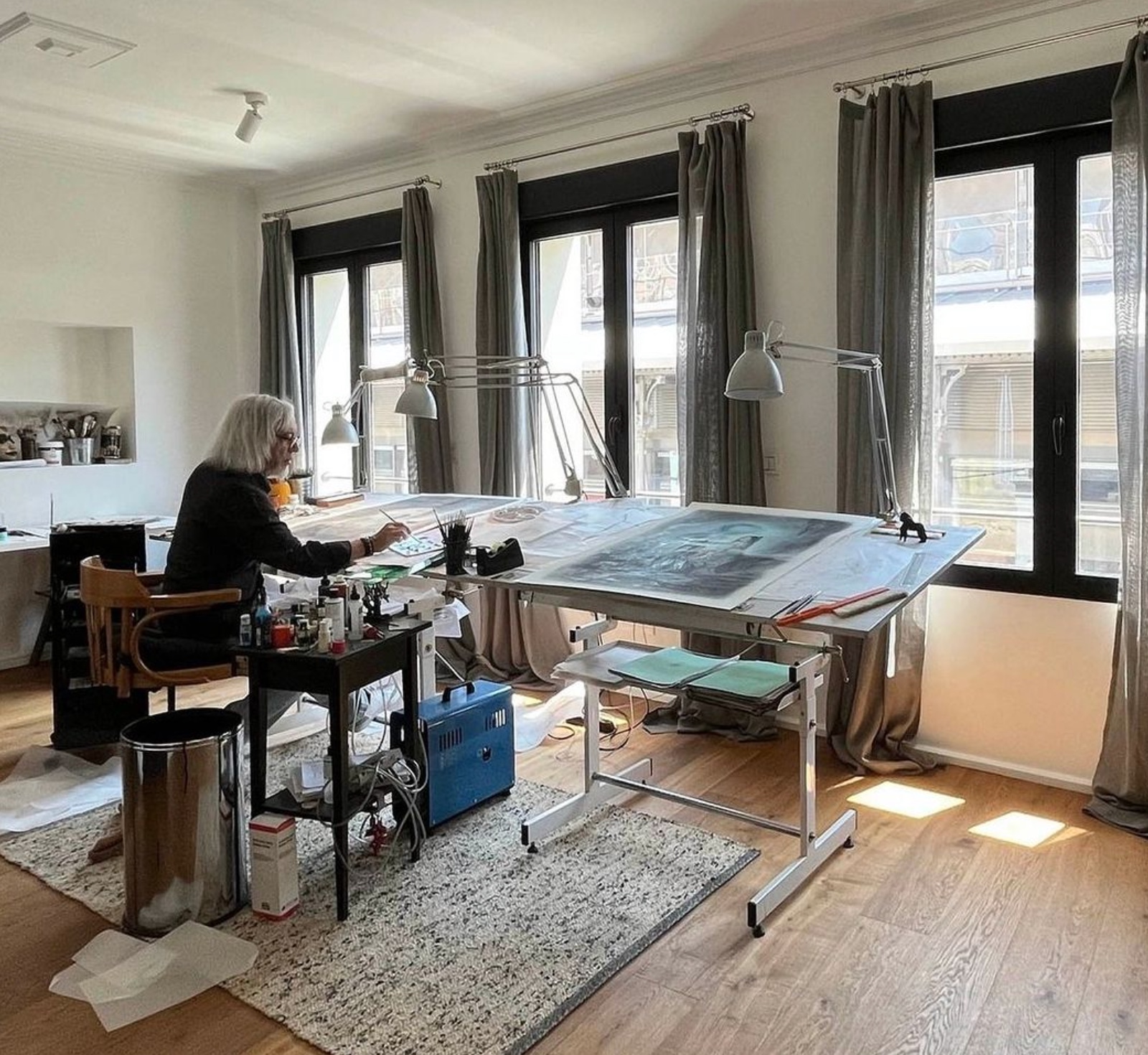
Is it necessary to get out of the comfort zone, or at least question it?
Luis: Always. Even plastically. You have such an assumed line that you can get into monotony. Then, you have to make a change, change the format or techniques. Sitting with insecurity in front of the easel or the drawing table is necessary. That tension that makes you be forced. At the moment that creates a routine or a comfort, it goes against the plastic arts. And it will be noticed because the work loses strength, loses life. If sometimes I have done a work without being in a good moment, when I take it in time I realize it. That’s what creativity is: you have to be in a situation in which you are not comfortable to be able to expel everything you can at that moment. When you get into a routine and you have all the technique super refined and the themes are the same… that’s it.
THAT’S WHAT CREATIVITY IS: YOU HAVE TO BE IN A SITUATION WHERE YOU’RE NOT COMFORTABLE TO BE ABLE TO EXPEL EVERYTHING YOU CAN AT THAT MOMENT… THAT’S IT.
How has your outlook changed as you have left your comfort zone?
Romulo: At the beginning I started with illustration, I also had Luis as a reference. I began to publish magazine covers, novels for Europe and I was also doing exhibitions and I saw that I wanted to exhibit, paint large formats, more expressive things that were not only for publication.
Then we started doing projects together. I also did personal things between painting, I was looking for media such as installations. I have been called to touch different disciplines. For example, I don’t consider myself a sculptor but I have made sculptures. I don’t see myself limited in support or in what I do. One likes to experiment.
Now it doesn’t happen so much but sometimes there has been the feeling that if you change too much it was even harmful for an author. He had to have a line, a mark. I like painters who have not changed much, but also those who have been changing. It is true that it gives you new visions.
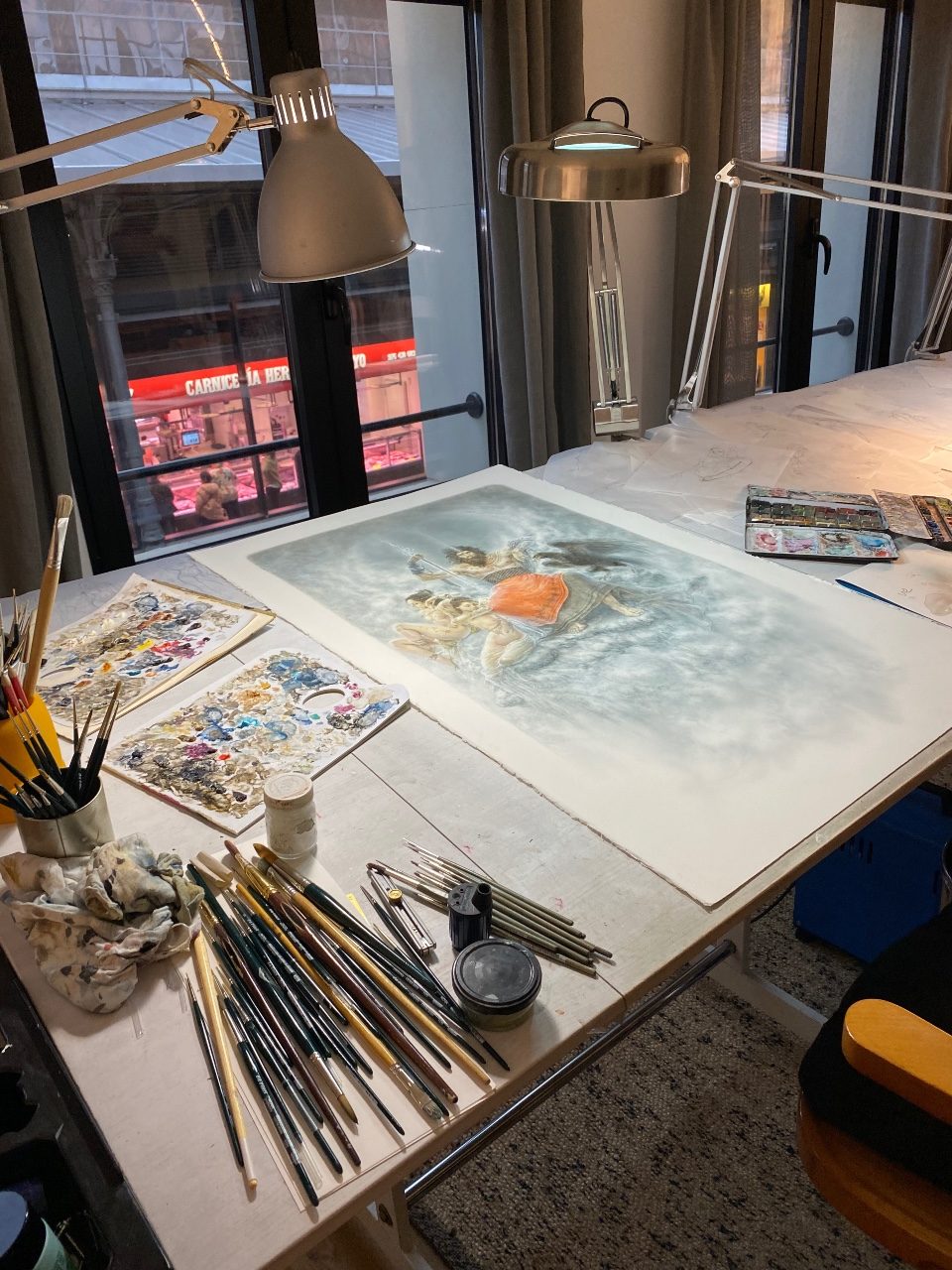
Luis: I am attracted to all this. It’s a constant, but possibly it comes from childhood, what we were talking about before, the inclination towards fantasy. An inclination to discover worlds and oneself because when you are drawing your imagination overflows. You get away from reality, you escape. That evasion has called me since I was a child. So, within that canon that is maintained [fantasy], from there one evolves from times where I have been very colorful and very detailed or meticulous, others with shades of gray or doing projects with Romulo.
Above all, don’t feel comfortable, even if you never change the subject. Challenging yourself is good, a continuous challenge. Whether you like watercolor, acrylic, oil, you go from one to another and you are no longer as comfortable as if you always used the same technique. Romulo sometimes has had periods with his paintings where the brushstroke is much looser and others where he has been conditioned to make it more detailed. If you set conditions, when you work, you vibrate and if there are no conditions and you get into a routine, the product you are making will die.
THE COMMISSION WAS VERY BADLY VALUED IN THOSE YEARS AND IT IS SOMETHING THAT HAS BEEN DONE ALL MY LIFE, ‘LAS MENINAS’ OR ‘LA CAPILLA SIXTINA’ ARE COMMISSIONS. THE COMMISSION IS A CHALLENGE
Luis, you illustrated a book by George RR Martin and you have renewed the design of DC Comic’s superheroes. How were these jobs? What was the challenge for you?
Luis: The commission was very poorly valued in those years and it is something that has been done all my life, ‘Las Meninas’ or ‘The Sistine Chapel’ are commissions. The commission is a challenge. Martin’s was within my guidelines, I have done many years of covers for fantasy books. There was a small challenge because it was a young adult novel and my work has never been either for children or for very teenagers because sometimes I’m hard on messages. In this book there are already some of the things we find later in Game of Thrones.
The DC thing is done by an American and Japanese house Yamato USA and they proposed to DC to make some figures and as I have been given the title of erotic illustrator they wanted to renew a little and, without losing their seal, give it this little touch of eroticism. We adapted, I would have made it more daring.

What synergies are established and how do you organize yourselves when you work together?
Romulo: I could talk about ‘Malefic Time’ which is already a few years old and it is the last project we did in collaboration and it was difficult because we wanted to differentiate it from the things we had done together in ‘Dead Moon’ and we broke quite a few pieces until we found the fusion. This has to do with what we were talking about the challenges. We know each other very well, so with a look sometimes we don’t need words. We are for the work, there is no ego. That is very difficult to achieve and to get to know each other. We know each other’s strengths, we look for them until they start to take shape.
Luis: One of the strengths is that: knowing each other so well and knowing each other’s work. That’s the advantage. We know where you can leave one thing for the other to continue it, you are very clear about it because you know that maybe he will get more out of it.
Romulo: There is one nice thing and that is that we are self-taught. Luis is self-taught with his technique and there is a magic in his way of doing things that is immediately recognizable. There are editors who say that you see the tip of a sword and you know it’s Luis Royo’s. His technique is unique. So it’s nice that we can merge two different techniques. In fact, that’s what they value outside and that’s why they want things from both of us. They also ask us separately.
Luis: They have told us that we have even renewed both our styles because when we get together we do something else. That has been appreciated. It’s a good thing.
Rómulo: Yes, it’s lucky because it’s difficult to happen.
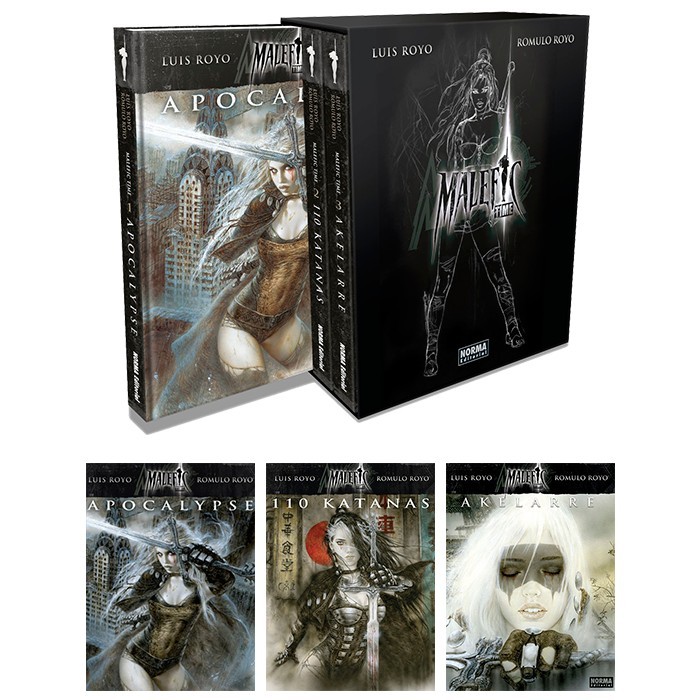
Malefic Time’ was born with the vocation of a total work.
Luis: It had the projection of being bigger, but the crisis hit the publishing world and they had to be much more prudent. The project was very big and ambitious and it was to unite everything: music, novel, role-playing games, board games… The novel has been made once but the project was to make three. The project was taken to ARCO, before it was unthinkable to take a project of a figurative apocalyptic story to ARCO. It was unexpected.
Romulo: It was curious because exhibitions were held in popular game or fantasy fairs and contemporary art fairs and it was also a challenge.
Luis: We even thought of a film project but it was left up in the air. Some American publishers disappeared and others were left in the dust.
Romulo: It was caught in the 2008 crisis and although it was published internationally, it could have been more.
Your biggest work as a whole is a copula that you painted in Moscow. Tell us a little about that project.
Luis: The Moscow dome was a commission. A Russian came to Barcelona to do the commission. When I was young I had done a dome for some friends who had a pub and I had a bad back because it is very hard and as I knew it we rejected it. But talking with Romulo we thought how could we miss a dome in Moscow. We spent six months preparing it here so we could get there and have everything super calculated: we took the oils, the brushes, the turpentine, we didn’t want any surprises. We took the life-size drawings with us to get there and capture them.
How long did you stay?
Romulo: We spent four months painting long hours.
Luis: No Sundays off or anything.
Rómulo: We preferred it that way too. We wanted to paint and then come back. It was to be focused only on the dome. At 7 o’clock they would pick us up and we would be there until 8 o’clock in the evening.
Luis: It would have been harder if we had extended it much longer, it was a job to do and not see anything else in the world except the dome day and night. Even so, physically it was hard. What was very nice is that it was a scaffolding was made of wood like in the Renaissance. Those four months were like living in the Renaissance, almost without communication; I spoke almost no English, pure isolation. As an incredible experience. The Russian world is quite different, it was a strong cultural shock.

What do you admire about each other?
Romulo: I admire that he has such a personal style, something that very few have. I also admire that he has created a universe. He is a reference, he has created a school and that is very difficult.
Luis: I admire Romulo’s love for gigantic sizes. He often projects them bigger and holds back. Paintings of these dimensions, when you make figurative and compositions, take time. It is not the same as painting an abstract, you have to measure forces.
I come from the opposite, I try not to make the piece too big, so that it doesn’t overflow me. However, I come here to see him and he is already preparing an easel. This is another challenge I still have to face: the looseness of the brushstroke. The large size gives a freshness to the brushstroke, the gesture of the whole body, which does not suit the small piece. That part that Romulo has makes me envious, it’s the challenge I should set myself, that of loosening the brushstroke.
Are you working on any project that can be moved forward?
Luis: We are in the middle of an embedded project. We are documenting a lot but it is germinating, we don’t even have the graphic line and it is going to be a whole. It is just being born.
Is it difficult to make your work known living in Zaragoza? Have you considered living in another city?
Rómulo: I have been living for years in Barcelona, in Madrid. Before it made more sense, but the centers are becoming more and more blurred. I suppose that being in New York will be easier than being in Zaragoza, but it is no longer the case that everything happens in New York, Berlin, Paris. It is no longer so important where the work is, what is important is that the work is seen where it has to be seen, that the agent you have moves your work.
Luis: The Internet has done a lot. Maybe at a time in your life when you’re sucking information, it’s good to live outside, but then at times when you’re taking it outside, living in places like this may not help you because you need a little seclusion.














